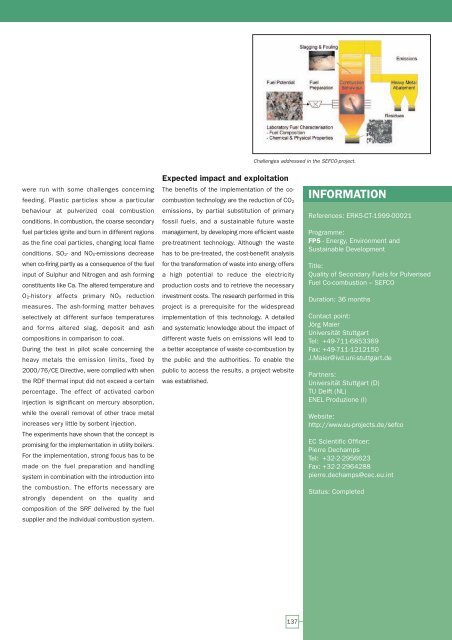European Bio-Energy Projects
European Bio-Energy Projects
European Bio-Energy Projects
You also want an ePaper? Increase the reach of your titles
YUMPU automatically turns print PDFs into web optimized ePapers that Google loves.
were run with some challenges concerning<br />
feeding. Plastic particles show a particular<br />
behaviour at pulverized coal combustion<br />
conditions. In combustion, the coarse secondary<br />
fuel particles ignite and burn in different regions<br />
as the fine coal particles, changing local flame<br />
conditions. SO2- and NOX-emissions decrease<br />
when co-firing partly as a consequence of the fuel<br />
input of Sulphur and Nitrogen and ash forming<br />
constituents like Ca. The altered temperature and<br />
O2-history affects primary NOX reduction<br />
measures. The ash-forming matter behaves<br />
selectively at different surface temperatures<br />
and forms altered slag, deposit and ash<br />
compositions in comparison to coal.<br />
During the test in pilot scale concerning the<br />
heavy metals the emission limits, fixed by<br />
2000/76/CE Directive, were complied with when<br />
the RDF thermal input did not exceed a certain<br />
percentage. The effect of activated carbon<br />
injection is significant on mercury absorption,<br />
while the overall removal of other trace metal<br />
increases very little by sorbent injection.<br />
The experiments have shown that the concept is<br />
promising for the implementation in utility boilers.<br />
For the implementation, strong focus has to be<br />
made on the fuel preparation and handling<br />
system in combination with the introduction into<br />
the combustion. The efforts necessary are<br />
strongly dependent on the quality and<br />
composition of the SRF delivered by the fuel<br />
supplier and the individual combustion system.<br />
Expected impact and exploitation<br />
The benefits of the implementation of the cocombustion<br />
technology are the reduction of CO2<br />
emissions, by partial substitution of primary<br />
fossil fuels, and a sustainable future waste<br />
management, by developing more efficient waste<br />
pre-treatment technology. Although the waste<br />
has to be pre-treated, the cost-benefit analysis<br />
for the transformation of waste into energy offers<br />
a high potential to reduce the electricity<br />
production costs and to retrieve the necessary<br />
investment costs. The research performed in this<br />
project is a prerequisite for the widespread<br />
implementation of this technology. A detailed<br />
and systematic knowledge about the impact of<br />
different waste fuels on emissions will lead to<br />
a better acceptance of waste co-combustion by<br />
the public and the authorities. To enable the<br />
public to access the results, a project website<br />
was established.<br />
Challenges addressed in the SEFCO-project.<br />
137<br />
INFORMATION<br />
References: ERK5-CT-1999-00021<br />
Programme:<br />
FP5 - <strong>Energy</strong>, Environment and<br />
Sustainable Development<br />
Title:<br />
Quality of Secondary Fuels for Pulverised<br />
Fuel Co-combustion – SEFCO<br />
Duration: 36 months<br />
Contact point:<br />
Jörg Maier<br />
Universität Stuttgart<br />
Tel: +49-711-6853369<br />
Fax: +49-711-1212150<br />
J.Maier@ivd.uni-stuttgart.de<br />
Partners:<br />
Universität Stuttgart (D)<br />
TU Delft (NL)<br />
ENEL Produzione (I)<br />
Website:<br />
http://www.eu-projects.de/sefco<br />
EC Scientific Officer:<br />
Pierre Dechamps<br />
Tel: +32-2-2956623<br />
Fax: +32-2-2964288<br />
pierre.dechamps@cec.eu.int<br />
Status: Completed

















